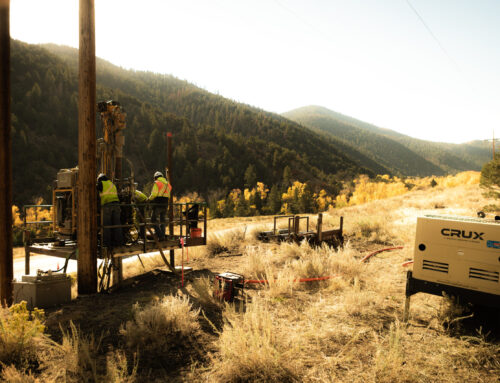
Steep Slope Micropile Foundation Design-Build
Kirkwood Meadows Public Utility District (KMPUD) commissioned the Out Valley Electrical Project to provide reliable electrical grid service near South Lake Tahoe. The project consisted of a 24.8-mile, 34.5 kV underground transmission line; two new substations; and construction of two new overhead transmission lines. The two overhead transmission lines, one 1.3-mile 115 kV line and one 1.8-mile 34.5 kV, run parallel to one another and utilize the same support structures.
Team Members
Kirkwood Meadows Public Utility District
Wilson Construction
Crux Subsurface
Crux’s Role
Crux provided specialty foundation design and construction for a portion of the overhead alignments between Salt Springs Reservoir and Lower Bear Reservoir. The lines were constructed within an existing PG&E, and resulted in construction activities taking place within immediate proximity to energized lines. Additionally, all construction activities took place within Forest Service (USFS) Land, requiring agency coordination and environmental regulatory compliance.
Tubular steel poles were erected on a combination of direct embeds, pier foundations, and steel cap micropile foundations, depending on the conditions at each structure. Micropiles were selected at 20 locations for a number of reasons, including steep slopes and near-surface rock. A unique leveling platform allowed for micropile installation on 1:1 (or steeper) slopes, and the lightweight nature of the materials and equipment used allowed for efficient helicopter transport to these difficult-to-access sites. Several sites also featured large boulders or near-surface rock, conditions in which micropiles are extremely effective. No blasting was required, which was an attractive feature to USFS officials.
Specific challenges of the project included operating helicopter long lines on steep slopes and in close proximity to energized lines. In the most extreme cases, equipment was set up with just 10 feet of overhead clearance from energized lines. Operating at 6,000-foot elevations in extremely high winds contributed to these challenges and required close coordination between helicopter pilots and crew members on the ground. The construction schedule also presented challenges when impacted by environmental restrictions and bad weather. Activities needed to be rescheduled to fit within a shorter time frame as the owner-mandated completion date remained unchanged. All foundation work was successfully completed within the allotted time frame.







